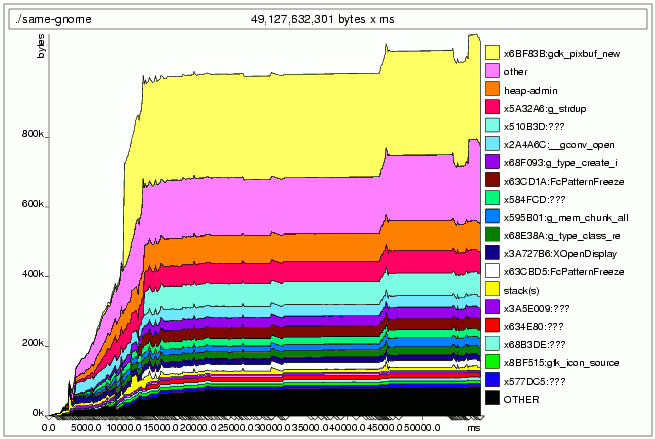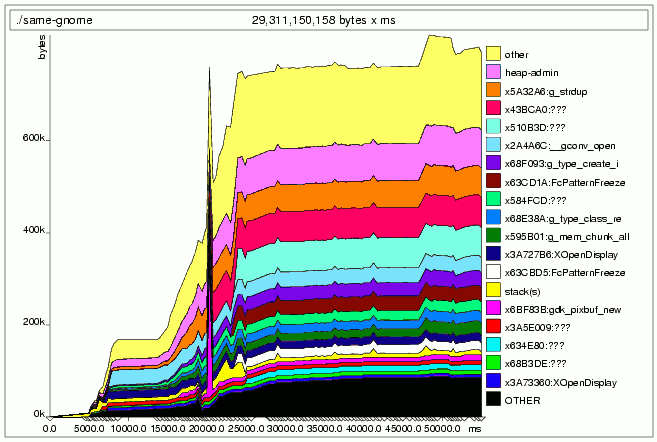Massif¶
Massif is a member of the Valgrind suite of memory-profiling tools. Its purpose is to give a detailed view of dynamic memory usage during the lifetime of the program. Specifically it records the memory use of the heap and the stack.
The heap is the region of memory which is allocated with functions like malloc.
It grows on demand and is usually the largest region of memory in a program. The
stack is where all the local data for functions is stored. This includes the
“automatic” variables in C and the return address for subroutines. The stack is
typically a lot smaller and a lot more active than the heap. We won’t consider
the stack explicitly since Massif treats it as though it were just another part
of the heap. Massif also gives information about how much memory is used to
manage the heap.
Massif produces two output files: a graphical overview in a postscript file and a detailed breakdown in a text file.
Using Massif with GNOME¶
Massif has very few options and for many programs does not need them. However
for GNOME applications, where memory allocation might be buried deep in either
glib or GTK, the number of levels down the call-stack Massif descends needs to
be increased. This is achieved using the --depth parameter. By default this is
3; increasing it to 5 will guarantee the call-stack reaches down to your code.
One or two more levels may also be desirable to provide your code with some
context. Since the level of detail becomes quickly overwhelming it is best to
start with the smaller depth parameter and only increase it when it becomes
apparent that it isn’t sufficient.
It is also useful to tell Massif which functions allocate memory in GLib. It
removes an unnecessary layer of function calls from the reports and gives you a
clearer idea of what code is allocating memory. The allocating functions in GLib
are g_malloc, g_malloc0, g_realloc, g_try_malloc, and
g_mem_chunk_alloc. You use the --alloc-fn option to tell Massif about
them.
Your command-line should therefore look something like:
valgrind --tool=massif \
--depth=5 \
--alloc-fn=g_malloc \
--alloc-fn=g_realloc \
--alloc-fn=g_try_malloc \
--alloc-fn=g_malloc0 \
--alloc-fn=g_mem_chunk_alloc \
swell-foop
Swell Foop is the program we will be using as an example. Be warned that, since valgrind emulates the CPU, it will run very slowly. You will also need a lot of memory.
An example of Massif-guided optimization¶
Interpreting the Results¶
The graphical output of Massif is largely self explanatory. Each band represents the memory allocated by one function over time. Once you identify which bands are using the most memory, usually the big thick ones at the top you will have to consult the text file for the details.
The text file is arranged as a hierarchy of sections, at the top is a list of the worst memory users arranged in order of decreasing spacetime. Below this are further sections, each breaking the results down into finer detail as you proceed down the call-stack. To illustrate this we will use the output of the command above.

Massif output for the unoptimized version of the Swell Foop program.¶
The image above shows a typical postscript output from Massif. This is the
result you would get from playing a single game of Swell Foop (version 2.8.0)
and then quitting. The postscript file will have a name like massif.12345.ps
and the text file will be called massif.12345.txt. The number in the middle
is the process ID of the program that was examined. If you actually try this
example you will find two versions of each file, with slightly different
numbers, this is because Swell Foop starts a second process and Massif follows
that too. We will ignore this second process, it consumes very little memory.
At the top of the graph we see a large yellow band labelled gdk_pixbuf_new.
This seems like an ideal candidate for optimization, but we will need to use the
text file to find out what is calling gdk_pixbuf_new. The top of the text
file will look something like this:
Command: ./swell-foop
== 0 ===========================
Heap allocation functions accounted for 90.4% of measured spacetime
Called from:
28.8% : 0x6BF83A: gdk_pixbuf_new (in /usr/lib/libgdk_pixbuf-2.0.so.0.400.9)
6.1% : 0x5A32A5: g_strdup (in /usr/lib/libglib-2.0.so.0.400.6)
5.9% : 0x510B3C: (within /usr/lib/libfreetype.so.6.3.7)
3.5% : 0x2A4A6B: __gconv_open (in /lib/tls/libc-2.3.3.so)
The line with the ‘=’ signs indicates how far down the stack trace we are, in
this case we are at the top. After this it lists the heaviest users of memory in
order of decreasing spacetime. Spacetime is the product of the amount of memory
used and how long it was used for. It corresponds to the area of the bands in
the graph. This part of the file tells us what we already know: most of the
spacetime is dedicated to gdk_pixbuf_new. To find out what called
gdk_pixbuf_new we need to search further down the text file:
== 4 ===========================
Context accounted for 28.8% of measured spacetime
0x6BF83A: gdk_pixbuf_new (in /usr/lib/libgdk_pixbuf-2.0.so.0.400.9)
0x3A998998: (within /usr/lib/gtk-2.0/2.4.0/loaders/libpixbufloader-png.so)
0x6C2760: (within /usr/lib/libgdk_pixbuf-2.0.so.0.400.9)
0x6C285E: gdk_pixbuf_new_from_file (in /usr/lib/libgdk_pixbuf-2.0.so.0.400.9)
Called from:
27.8% : 0x804C1A3: load_scenario (swell-foop.c:463)
0.9% : 0x3E8095E: (within /usr/lib/libgnomeui-2.so.0.792.0)
and 1 other insignificant place
The first line tells us we are now four levels deep into the stack. Below it is
a listing of the function calls that leads from here to gdk_pixbuf_new.
Finally there is a list of functions that are at the next level down and call
these functions. There are, of course, also entries for levels 1, 2, and 3, but
this is the first level to reach right down through the GDK code to the Swell
Foop code. From this listing, we can see instantly that the problem code is
load_scenario.
Now that we know what part of our code is using all the spacetime we can look at
it and find out why. It turns out that the load_scenario is loading a pixbuf
from file and then never freeing that memory. Having identified the problem
code, we can start to fix it.
Acting on the Results¶
Reducing spacetime consumption is good, but there are two ways of reducing it and they are not equal. You can either reduce the amount of memory allocated, or reduce the amount of time it is allocated for. Consider for a moment a model system with only two processes running. Both processes use up almost all the physical RAM and if they overlap at all then the system will swap and everything will slow down. Obviously if we reduce the memory usage of each process by a factor of two then they can peacefully coexist without the need for swapping. If instead we reduce the time the memory is allocated by a factor of two then the two programs can coexist, but only as long as their periods of high memory use don’t overlap. So it is better to reduce the amount of memory allocated.
Unfortunately, the choice of optimization is also constrained by the needs of the program. The size of the pixbuf data in Swell Foop is determined by the size of the game’s graphics and cannot be easily reduced. However, the amount of time it spends loaded into memory can be drastically reduced. The image below shows the Massif analysis of Swell Foop after being altered to dispose of the pixbufs once the images have been loaded into the X server.

Massif output for the optimized Swell Foop program.¶
The spacetime use of gdk_pixbuf_new is now a thin band that only spikes
briefly (it is now the sixteenth band down and shaded magenta). As a bonus, the
peak memory use has dropped by 200 kB since the spike occurs before other memory
is allocated. If two processes like this were run together the chances of the
peak memory usage coinciding, and hence the risk of swapping, would be quite
low.
Can we do better? A quick examination of Massif’s text output reveals:
g_strdup to be the new major offender.
Command: ./swell-foop
== 0 ===========================
Heap allocation functions accounted for 87.6% of measured spacetime
Called from:
7.7% : 0x5A32A5: g_strdup (in /usr/lib/libglib-2.0.so.0.400.6)
7.6% : 0x43BC9F: (within /usr/lib/libgdk-x11-2.0.so.0.400.9)
6.9% : 0x510B3C: (within /usr/lib/libfreetype.so.6.3.7)
5.2% : 0x2A4A6B: __gconv_open (in /lib/tls/libc-2.3.3.so)
If we look closer though we see that it is called from many, many, places.
== 1 ===========================
Context accounted for 7.7% of measured spacetime
0x5A32A5: g_strdup (in /usr/lib/libglib-2.0.so.0.400.6)
Called from:
1.8% : 0x8BF606: gtk_icon_source_copy (in /usr/lib/libgtk-x11-2.0.so.0.400.9)
1.1% : 0x67AF6B: g_param_spec_internal (in /usr/lib/libgobject-2.0.so.0.400.6)
0.9% : 0x91FCFC: (within /usr/lib/libgtk-x11-2.0.so.0.400.9)
0.8% : 0x57EEBF: g_quark_from_string (in /usr/lib/libglib-2.0.so.0.400.6)
and 155 other insignificant places
We now face diminishing returns for our optimization efforts. The graph hints at another possible approach: Both the “other” and “heap admin” bands are quite large. This tells us that there are a lot of small allocations being made from a variety of places. Eliminating these will be difficult, but if they can be grouped then the individual allocations can be larger and the “heap admin” overhead can be reduced.
Caveats¶
There are a couple of things to watch out for: Firstly, spacetime is only reported as a percentage, you have to compare it to the overall size of the program to decide if the amount of memory is worth pursuing. The graph, with its kilobyte vertical axis, is good for this.
Secondly, Massif only takes into account the memory used by your own program. If your application uses IPC and references objects on different processes, Massif won’t consider their memory footprint. In the Swell Foop example we have actually only moved the memory consumption from client-side pixbufs to server-side pixmaps. Even though we cheated there are performance gains: keeping the image data in the X server makes the graphics routines quicker and removes a lot of inter-process communication.